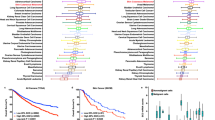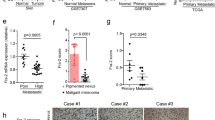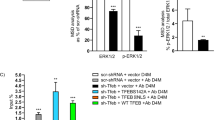Abstract
Purpose
Fatty acid-binding protein 7 (FABP7) involved in intracellular lipid dynamics, is highly expressed in melanomas and associated with decreased patient survival. Several studies put FABP7 at the center of melanoma cell proliferation. However, the underlying mechanisms are not well deciphered. This study examines the effects of FABP7 on Wnt/β-catenin signaling that enhances proliferation in melanoma cells.
Methods
Skmel23 cells with FABP7 silencing and Mel2 cells overexpressed with wild-type FABP7 (FABP7wt) and mutated FABP7 (FABP7mut) were used. Cell proliferation and migration were analyzed by proliferation and wound-healing assay, respectively. Transcriptional activation of the Wnt/β-catenin signaling was measured by luciferase reporter assay. The effects of a specific FABP7 inhibitor, MF6, on proliferation, migration, and modulation of the Wnt/β-catenin signaling were examined.
Results
FABP7 siRNA knockdown in Skmel23 decreased proliferation and migration, cyclin D1 expression, as well as Wnt/β-catenin activity. Similarly, FABP7wt overexpression in Mel2 cells increased these effects, but FABP7mut abrogated these effects. Pharmacological inhibition of FABP7 function with MF6 suppressed FABP7-regulated proliferation of melanoma cells.
Conclusion
These results suggest the importance of the interaction between FABP7 and its ligands in melanoma proliferation modulation, and the beneficial implications of therapeutic targeting of FABP7 for melanoma treatment.




Similar content being viewed by others
Abbreviations
- CCND1:
-
Cyclin D1
- DHA:
-
Docosahexaenoic acid
- EPA:
-
Eicosapentaenoic acid
- FABP7:
-
Fatty acid binding protein 7
- GAPDH:
-
Glyceraldehyde 3-phosphate dehydrogenase
- GSK3β:
-
Glycogen synthase kinase-3β
- LCFAs:
-
Long chain fatty acids
- MF6:
-
4-(2-(5-(2-chlorophenyl)-1-(4-isopropylphenyl)-1H-pyrazol-3-yl)-4-fluorophenoxy) butanoic acid
- MUFAs:
-
Monounsaturated fatty acids
- PUFAs:
-
Polyunsaturated fatty acids
- TCF/LEF:
-
T cell factor/lymphoid-enhancing factor
References
Schadendorf D, van Akkooi ACJ, Berking C, Griewank KG, Gutzmer R, Hauschild A, et al. Melanoma. The Lancet. Lancet Publishing Group. 2018;392:971–84.
Flaherty KT, Puzanov I, Kim KB, Ribas A, McArthur GA, Sosman JA, et al. Inhibition of mutated, activated BRAF in metastatic melanoma. N Engl J Med [Internet]. 2010 Aug 26 [cited 2020 Aug 17];363(9):809–19 Available from: https://pubmed.ncbi.nlm.nih.gov/20818844/.
Kong Y, Kumar SM, Xu X. Molecular pathogenesis of sporadic melanoma and melanoma-initiating cells. Arch Pathol Lab Med [Internet]. 2010 Dec [cited 2020 Aug 26];134(12):1740–9. Available from: /pmc/articles/PMC4049155/?report=abstract.
Abildgaard C, Guldberg P. Molecular drivers of cellular metabolic reprogramming in melanoma. Vol. 21, Trends in Molecular Medicine. Elsevier Ltd; 2015. p. 164–171.
Colombino M, Capone M, Lissia A, Cossu A, Rubino C, De Giorgi V, et al. BRAF/NRAS mutation frequencies among primary tumors and metastases in patients with melanoma. J Clin Oncol [Internet]. 2012 Jul 10 [cited 2020 Aug 24];30(20):2522–9. Available from: https://pubmed.ncbi.nlm.nih.gov/22614978/
Rubinfeld B, Robbins P, El-Gamil M, Albert I, Porfiri E, Polakis P. Stabilization of β-catenin by genetic defects in melanoma cell lines. Science (80- ) [Internet]. 1997 Mar 21 [cited 2020 Aug 24];275(5307):1790–2. Available from: http://science.sciencemag.org/
Worm J, Christensen C, Grønbæk K, Tulchinsky E, Guldberg P. Genetic and epigenetic alterations of the APC gene in malignant melanoma. Oncogene [Internet]. 2004 Jul 1 [cited 2020 Aug 26];23(30):5215–26. Available from: https://pubmed.ncbi.nlm.nih.gov/15133491/
Sinnberg T, Levesque MP, Krochmann J, Cheng PF, Ikenberg K, Meraz-Torres F, et al. Wnt-signaling enhances neural crest migration of melanoma cells and induces an invasive phenotype. Mol Cancer [Internet]. 2018 Feb 17 [cited 2020 Aug 24];17(1):59. Available from: https://molecular-cancer.biomedcentral.com/articles/10.1186/s12943-018-0773-5
Gallagher SJ, Rambow F, Kumasaka M, Champeval D, Bellacosa A, Delmas V, et al. Beta-catenin inhibits melanocyte migration but induces melanoma metastasis. Oncogene [Internet]. 2013 [cited 2020 Aug 26];32(17):2230–8. Available from: /pmc/articles/PMC3637425/?report=abstract.
MacDonald BT, Tamai K, He X. Wnt/β-Catenin Signaling: Components, Mechanisms, and Diseases [Internet]. Vol. 17, Developmental Cell. Dev Cell; 2009 [cited 2020 Aug 24]. p. 9–26. Available from: https://pubmed.ncbi.nlm.nih.gov/19619488/
Liu C, Li Y, Semenov M, Han C, Baeg GH, Tan Y, et al. Control of β-catenin phosphorylation/degradation by a dual-kinase mechanism. Cell [Internet]. 2002 Mar 22 [cited 2020 Aug 26];108(6):837–47. Available from: https://pubmed.ncbi.nlm.nih.gov/11955436/
Sinnberg T, Menzel M, Ewerth D, Sauer B, Schwarz M, Schaller M, et al. β-Catenin Signaling Increases during Melanoma Progression and Promotes Tumor Cell Survival and Chemoresistance. PLoS One [Internet]. 2011 [cited 2021 Jan 6];6(8):e23429. Available from: https://journals.plos.org/plosone/article?id=10.1371/journal.pone.0023429
Liu J, Pan S, Hsieh MH, Ng N, Sun F, Wang T, et al. Targeting Wnt-driven cancer through the inhibition of Porcupine by LGK974. Proc Natl Acad Sci U S A [Internet]. 2013 Dec 10 [cited 2020 Aug 26];110(50):20224–9. Available from: https://pubmed.ncbi.nlm.nih.gov/24277854/
Kansal S, Vaiphei K, Agnihotri N. Alterations in lipid mediated signaling and Wnt/β-catenin signaling in DMH induced colon cancer on supplementation of fish oil. Biomed Res Int [Internet]. 2014 [cited 2020 Aug 26];2014. Available from: /pmc/articles/PMC4066946/?report=abstract.
de Lorgeril M, Salen P. New insights into the health effects of dietary saturated and omega-6 and omega-3 polyunsaturated fatty acids [Internet]. Vol. 10, BMC Medicine. BMC Med; 2012 [cited 2020 Aug 30]. Available from: https://pubmed.ncbi.nlm.nih.gov/22613931/
Kim H, Rodriguez-Navas C, Kollipara RK, Kapur P, Pedrosa I, Brugarolas J, et al. Unsaturated fatty acids stimulate tumor growth through stabilization of β-catenin. Cell Rep [Internet]. 2015 Oct 20 [cited 2020 Aug 26];13(3):495–503. Available from: /pmc/articles/PMC4618234/?report=abstract.
Takada R, Satomi Y, Kurata T, Ueno N, Norioka S, Kondoh H, et al. Monounsaturated fatty acid modification of wnt protein: its role in Wnt secretion. Dev Cell [Internet]. 2006 Dec 1 [cited 2020 Aug 26];11(6):791–801. Available from: http://www.cell.com/article/S1534580706004552/fulltext
Fiorentino M, Zadra G, Palescandolo E, Fedele G, Bailey D, Fiore C, et al. Overexpression of fatty acid synthase is associated with palmitoylation of Wnt1 and cytoplasmic stabilization of β-catenin in prostate cancer. Lab Investig [Internet]. 2008 Dec [cited 2020 Aug 26];88(12):1340–8. Available from: https://pubmed.ncbi.nlm.nih.gov/18838960/
Kurtz A, Zimmer A, Schnütgen F, Brüning G, Spener F, Müller T. The expression pattern of a novel gene encoding brain-fatty acid binding protein correlates with neuronal and glial cell development. Development. 1994;120(9):2637–49.
Goto Y, Matsuzaki Y, Kurihara S, Shimizu A, Okada T, Yamamoto K, et al. A new melanoma antigen fatty acid-binding protein 7, involved in proliferation and invasion, is a potential target for immunotherapy and molecular target therapy. Cancer Res [Internet]. 2006 [cited 2020 Feb 27];66(8):4443–52. Available from: http://cancerres.aacrjournals.org/
de Rosa A, Pellegatta S, Rossi M, Tunici P, Magnoni L, Speranza MC, et al. A radial glia gene marker, fatty acid binding protein 7 (FABP7), is involved in proliferation and invasion of glioblastoma cells. PLoS One. 2012 Dec;25:7(12).
Nagao K, Shinohara N, Smit F, De Weijert M, Jannink S, Owada Y, et al. Fatty acid binding protein 7 may be a marker and therapeutic targets in clear cell renal cell carcinoma 11 medical and health sciences 1112 oncology and carcinogenesis. BMC Cancer. 2018 Nov;15:18(1).
Mita R, Beaulieu MJ, Field C, Godbout R. Brain fatty acid-binding protein and ω-3/ω-6 fatty acids: mechanistic insight into malignant glioma cell migration. J Biol Chem. 2010 Nov 19;285(47):37005–15.
Kagawa Y, Umaru BA, Shima H, Ito R, Zama R, Islam A, et al. FABP7 regulates acetyl-CoA metabolism through the interaction with ACLY in the nucleus of astrocytes. Mol Neurobiol [Internet]. 2020 Aug 19 [cited 2020 Sep 5];1–20. Available from: https://doi.org/10.1007/s12035-020-02057-3.
Kagawa Y, Umaru BA, Shil SK, Hayasaka K, Zama R, Kobayashi Y, et al. Mitochondrial dysfunction in GnRH neurons impaired GnRH production. Biochem Biophys Res Commun. 2020 Sep 10;530(1):329–35.
Shinoda Y, Wang Y, Yamamoto T, Miyachi H, Fukunaga K. Analysis of binding affinity and docking of novel fatty acid-binding protein (FABP) ligands. J Pharmacol Sci. 2020;143(4):264–71.
Liu JW, Almaguel FG, Bu L, De Leon DD, De Leon M. Expression of E-FABP in PC12 cells increases neurite extension during differentiation: involvement of n-3 and n-6 fatty acids. J Neurochem. 2008 Sep;106(5):2015–29.
Emami KH, Nguyen C, Ma H, Kim DH, Jeong KW, Eguchi M, et al. A small molecule inhibitor of β-catenin/cyclic AMP response element-binding protein transcription. Proc Natl Acad Sci U S A [Internet]. 2004 Aug 24 [cited 2021 Jan 4];101(34):12682–7. Available from: https://pubmed.ncbi.nlm.nih.gov/15314234/
Shimamoto C, Ohnishi T, Maekawa M, Watanabe A, Ohba H, Arai R, et al. Functional characterization of FABP3, 5 and 7 gene variants identified in schizophrenia and autism spectrum disorder and mouse behavioral studies. Hum Mol Genet [Internet]. 2014 Dec 15 [cited 2020 Sep 4];23(24):6495–511. Available from: /pmc/articles/PMC4240203/?report=abstract.
Ribas A, Gonzalez R, Pavlick A, Hamid O, Gajewski TF, Daud A, et al. Combination of vemurafenib and cobimetinib in patients with advanced BRAFV600-mutated melanoma: a phase 1b study. Lancet Oncol. 2014;15(9):954–65.
Hodi FS, O’Day SJ, McDermott DF, Weber RW, Sosman JA, Haanen JB, et al. Improved survival with ipilimumab in patients with metastatic melanoma. N Engl J Med [Internet]. 2010 Aug 19 [cited 2020 Aug 17];363(8):711–23. Available from: https://pubmed.ncbi.nlm.nih.gov/20525992/
Dummer R, Hauschild A, Lindenblatt N, Pentheroudakis G, Keilholz & U. Cutaneous melanoma: ESMO clinical practice guidelines for diagnosis, treatment and follow-up † on behalf of the ESMO guidelines committee incidence and epidemiology. ESMO Updat Clin Pract Guidel 2015;26:v126–v132.
Owada Y, Yoshimoto T, Kondo H. Spatio-temporally differential expression of genes for three members of fatty acid binding proteins in developing and mature rat brains. J Chem Neuroanat [Internet]. 1996 Dec [cited 2020 Sep 1];12(2):113–22. Available from: https://pubmed.ncbi.nlm.nih.gov/9115666/
Kagawa Y, Yasumoto Y, Sharifi K, Ebrahimi M, Islam A, Miyazaki H, et al. Fatty acid-binding protein 7 regulates function of caveolae in astrocytes through expression of caveolin-1. Glia [Internet]. 2015 May 1 [cited 2020 Oct 10];63(5):780–94. Available from: http://doi.wiley.com/10.1002/glia.22784
Hara T, Umaru BA, Sharifi K, Yoshikawa T, Owada Y, Kagawa Y. Fatty acid binding protein 7 is involved in the proliferation of reactive astrocytes, but not in cell migration and polarity. Acta Histochem Cytochem [Internet]. 2020 Jul 4 [cited 2020 Oct 10];53(4):73–81. Available from: https://europepmc.org/articles/PMC7450179
Colombo S, Champeval D, Rambow F, Larue L. Transcriptomic analysis of mouse embryonic skin cells reveals previously unreported genes expressed in melanoblasts. J Invest Dermatol [Internet]. 2012 [cited 2020 Sep 1];132(1):170–8. Available from: https://pubmed.ncbi.nlm.nih.gov/21850021/
Kagawa Y, Umaru BA, Ariful I, Shil SK, Miyazaki H, Yamamoto Y, et al. Role of FABP7 in tumor cell signaling. Vol. 71, Advances in Biological Regulation. Elsevier Ltd; 2019. p. 206–218.
Slipicevic A, Jørgensen K, Skrede M, Rosnes AKR, Trøen G, Davidson B, et al. The fatty acid binding protein 7 (FABP7) is involved in proliferation and invasion of melanoma cells. BMC Cancer [Internet]. 2008 Sep 30 [cited 2020 Sep 1];8(1):276. Available from: http://bmccancer.biomedcentral.com/articles/10.1186/1471-2407-8-276
Balendiran GK, Schnütgen F, Scapin G, Börchers T, Xhong N, Lim K, et al. Crystal structure and thermodynamic analysis of human brain fatty acid-binding protein. J Biol Chem. 2000 Sep 1;275(35):27045–54.
Maekawa M, Owada Y, Yoshikawa T. Role of polyunsaturated fatty acids and fatty acid binding protein in the pathogenesis of schizophrenia. Curr Pharm Des. 2011;17(2):168–75.
Bensaad K, Favaro E, Lewis CA, Peck B, Lord S, Collins JM, et al. Fatty acid uptake and lipid storage induced by HIF-1α contribute to cell growth and survival after hypoxia-reoxygenation. Cell Rep. 2014 Oct 9;9(1):349–65.
Kovacs D, Migliano E, Muscardin L, Silipo V, Catricalà C, Picardo M, et al. The role of Wnt/β-catenin signaling pathway in melanoma epithelial-to-mesenchymal-like switching: evidences from patients-derived cell lines. Oncotarget. 2016;7(28):43295–314.
Chien AJ, Moore EC, Lonsdorf AS, Kulikauskas RM, Rothberg BG, Berger AJ, et al. Activated Wnt/β-catenin signaling in melanoma is associated with decreased proliferation in patient tumors and a murine melanoma model. Proc Natl Acad Sci U S A. 2009 Jan 27;106(4):1193–8.
ACKNOWLEDGEMENT AND DISCLOSURES
We thank the Biomedical Research Unit of Tohoku University Hospital and the Biomedical Research Core (Tohoku University Graduate School of Medicine) for their support. The authors declare no competing interests.
Funding
This work was supported in part by Japan Society for the Promotion of Science (JSPS) KAKENHI Grant (No. 17 K15539 and 20 K11527 to Y.K., No. 19H04026 to Y. O.), in part by AMED under Grant Number JP17dm0107071 (to K.F. and Y.O.).
Author information
Authors and Affiliations
Contributions
Banlanjo Abdulaziz Umaru, Yoshiteru Kagawa. and Yuji Owada conceived and designed the study and wrote the manuscript with comments from all authors. Banlanjo Abdulaziz Umaru, Yoshiteru Kagawa, Subrata Kumar Shil, Naoki Arakawa, Hirofumi Miyazaki, Shuhei Kobayashi, Shuhan Yang, An Cheng, Yifei Wang, and Yasuharu Shinoda performed experiments. Yukiko Kiniwa, Ryuhei Okuyama, and Kohji Fukunaga provided reagents and technical assistance.
Corresponding author
Additional information
Publisher’s Note
Springer Nature remains neutral with regard to jurisdictional claims in published maps and institutional affiliations.
Supplementary Information
ESM 1
(PDF 1.05 mb)
Rights and permissions
About this article
Cite this article
Umaru, B.A., Kagawa, Y., Shil, S.K. et al. Ligand Bound Fatty Acid Binding Protein 7 (FABP7) Drives Melanoma Cell Proliferation Via Modulation of Wnt/β-Catenin Signaling. Pharm Res 38, 479–490 (2021). https://doi.org/10.1007/s11095-021-03009-9
Received:
Accepted:
Published:
Issue Date:
DOI: https://doi.org/10.1007/s11095-021-03009-9




